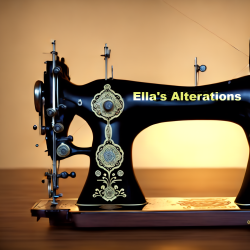Price and Timeline for Clothing Alterations: A Comprehensive Guide
The world of clothing alterations is vast and varied, encompassing everything from simple hem adjustments to intricate restyling of garments. Understanding the price and timeline for these alterations is essential for both consumers and professionals in the fashion industry. This article delves into the factors that influence the cost and time required for different types of clothing alterations.
Understanding the Basics
Clothing alterations are modifications made to a garment to improve its fit, style, or functionality. These can range from minor adjustments, such as shortening sleeves, to major overhauls like resizing a wedding gown. The price and timeline for these alterations depend on several factors, including the complexity of the work, the tailor’s expertise, the fabric’s quality, and the customer’s specific requirements.
Complexity of the Work
The complexity of the alteration plays a significant role in determining both the price and the timeline. Simple alterations, like hemming a pair of trousers or adjusting a waistband, typically cost less and can often be completed within a day or two.
In contrast, more complex alterations, such as resizing a suit jacket or modifying the structure of a dress, require more time and expertise. These alterations can take several days to a week to complete and are generally more expensive.
Tailor’s Expertise
The tailor’s expertise and reputation also influence the price and timeline for clothing alterations. A highly skilled and experienced tailor may charge more for their services but is likely to provide superior quality work. They may also have a longer waiting list, which can extend the timeline for completing the alterations.
On the other hand, a less experienced tailor may offer quicker turnaround times and lower prices. However, the quality of work may not be as high, and there may be risks associated with entrusting a valuable garment to someone with limited experience.
Fabric Quality
The type and quality of the fabric being altered can also impact the price and timeline. Delicate fabrics like silk or lace require careful handling and specialized techniques, which can increase both the cost and the time required for alterations.
Heavier fabrics like wool or denim may be more straightforward to work with but can still present challenges, particularly if the alterations involve significant structural changes. The tailor’s familiarity with different fabrics and their ability to work with them efficiently will play a role in determining the overall cost and timeline.
Customer Requirements
The specific requirements of the customer can also influence the price and timeline for clothing alterations. If a customer needs a garment altered quickly for a special event, they may need to pay a rush fee for expedited service. Conversely, if the customer is flexible with the timeline, they may be able to negotiate a lower price.
Customizations and special requests, such as adding embellishments or making unique design changes, can also add to the cost and time required for alterations. Clear communication between the tailor and the customer is essential to ensure that expectations are aligned and that the final product meets the customer’s needs.
Geographic Location
The geographic location of the tailor or alteration shop can also impact the price and timeline. In larger cities or more affluent areas, prices may be higher due to increased overhead costs and higher demand for services. The competition among tailors in these areas may also influence pricing and availability.
In smaller towns or less densely populated regions, prices may be lower, but the availability of skilled tailors and quick turnaround times may be more limited. The local market dynamics and cost of living will play a role in determining the overall price and timeline for clothing alterations in a given area.
Seasonal Factors
Seasonal factors can also influence the price and timeline for clothing alterations. During peak wedding season or around major holidays, tailors may be inundated with requests for alterations, leading to longer wait times and potentially higher prices.
Similarly, the demand for certain types of alterations may vary with the seasons. For example, requests for coat alterations may increase in the fall and winter, while alterations for summer dresses may peak in the spring and summer. Understanding these seasonal trends can help customers plan ahead and potentially save both time and money.
Online vs. In-Person Alterations
The rise of online tailoring services has introduced a new dimension to the price and timeline for clothing alterations. Online tailors often offer competitive pricing and the convenience of remote consultations and fittings. However, the timeline for online alterations may be extended due to shipping and the potential need for additional adjustments once the garment is received.
In-person alterations, on the other hand, provide the opportunity for face-to-face consultations and fittings, allowing for more precise adjustments and personalized service. While in-person alterations may be more expensive and time-consuming, many customers value the hands-on approach and the ability to see and feel the garment throughout the alteration process.
Conclusion
The price and timeline for clothing alterations are influenced by a complex interplay of factors, including the complexity of the work, the tailor’s expertise, the fabric’s quality, customer requirements, geographic location, seasonal factors, and the choice between online and in-person services.
Understanding these factors can help customers make informed decisions and find the right balance between cost, quality, and convenience. It can also assist tailors in setting fair prices and managing customer expectations.
Ultimately, the success of a clothing alteration depends on clear communication, skilled craftsmanship, and a shared understanding of the desired outcome. By considering the various factors that influence the price and timeline, both tailors and customers can work together to achieve the perfect fit and create garments that are both beautiful and functional.
Previous: Tailoring Basics Next Up: What to Look for When Choosing a Tailor
